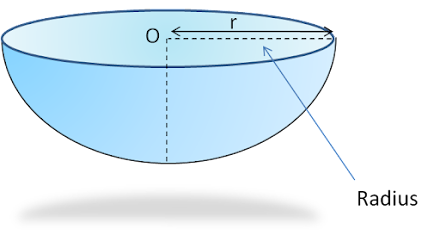Geometry, properties, mensuration formula 3D
Three-dimensional shapes (Solid shapes)
Three-dimensional shapes have length, width and height. Three-dimensional shapes can only be defined in a 3D Co-ordinate geometry. The properties and formulas of all three-dimensional shapes in mathematics are given below.
Cube
The cube is made up of 6 squares. its length, width and height are equal.
Properties-
Surface- 6
Edges- 12
Vertices- 8
Formulas-
Total surface area = 6(side)2
Lateral surface area = 4(side)2
Volume = (side)3
Diagonal = \(side\sqrt {3}\)
Cuboid
It is made up of 6 rectangles. its length, width and height are different.
Properties-
Surface- 6
Edges- 12
Vertices- 8
Formulas-
Total surface area = 2(L✕W + W✕H + H✕L)
Lateral surface area = 2(W✕H + H✕L)
Volume = Leight✕Width(breath)✕Height =L✕W✕H
Diagonal = \(\sqrt {L^2 + W^2 + H^2}\)
Euler's Formula
Euler's Formula for polyhedral figures like cubes and cuboids.
V + F - E = 2
F- Surfaces/Faces
E- Edges
V- Vertices
Cylinder
The top and bottom surfaces of the cylinder are circular and the side is covered with a curved surface.
Formulas-
Curved surface area = 2πrh
Total surface area = 2πrh + πr2 + πr2 = 2πr(h + r)
Volume = πr2h
r ⟶ Radius of the cylinder
h ⟶ Height of cylinder
Hollow cylinder
The hollow cylinder's top and bottom surfaces are ring surfaces with two curved surfaces. Outer curved surface and inner-curved surface.
Formulas-
Curved surface area = 2πRh + 2πrh = 2πrh(R + r)
Total surface area = 2πrh(R + r) + 2(πR2 - πr2) = 2π(R + r) (h + R - r)
Volume = πR2h - πr2h = πh(R2 - r2)
R ⟶ Radius of the outer cylinder
r ⟶ Radius of the inner cylinder
h ⟶ Height of cylinder
Cone
Cone has a flat circular base and a pointed top. The pointed top of the cone is called the 'Apex' and the side is covered with a curved surface.
Formulas-
Curved surface area = \(\frac {1}{2} ✕ perimeter \space of \space base ✕ slant \space height \)
= \(\frac {1}{2} ✕ 2πr ✕ l \) = πrl
Total surface area = πrl + πr2 = πr(l + r)
Volume = \(\frac {1}{3} ✕ πr^2h \)
l = \( \sqrt {r^2 + h^2} \)
h ⟶ Height of the cone
r ⟶ Radius of the cone
l ⟶ Slant height of the cone
Frustum
If we cut off the top end of the cone, we get a frustum.
Formulas-
Curved surface area = πrl + πRl
Total surface area = πl (r + R) + πr2 + πR2 = πl(r + R) + π(r2 + R2)
Volume = \(\frac {πh}{3} ✕ (r^2 + R^2 + Rr) \)
l = \( \sqrt {(R - r)^2 + h^2} \)
h ⟶ Height of the cone
R ⟶ Radius of the base
r ⟶ Radius of the top
l ⟶ Slant height of the frustum
Sphere
The sphere has no vertex or edge. It looks similar from all sides just like a ball.
Formulas-
Curved surface area or Total surface area = 4πr2
Volume = \(\frac {4}{3} ✕ πr^3 \)
Semisphere
If the sphere is cut from the middle, then a semisphere is obtained.
Formulas-
Curved surface area = 2πr2
Total surface area = 2πr2 + πr2 = 3πr2
Volume = \(\frac {2}{3} ✕ πr^3 \)
Prism
The prism consists of identical polygons at the top and bottom.
Formulas-
Lateral surface area = Perimeter of base ✕ Height
Total surface area = Perimeter of base ✕ Height + 2✕area of the triangle
Volume = Area of base ✕ height
Pyramid
It has a square at its base but has triangles of equal size on all four sides.
Lateral surface area = \( \frac {1}{2}✕Perimeter \space of \space base ✕ slant \space Height \)
Total surface area = \( \frac {1}{2}✕Perimeter \space of \space base ✕ slant \space Height + area \space of \space base \)
Volume = \( \frac {1}{3}✕area \space of \space base ✕ Height \)
l = \( \sqrt {h^2 + a^2} \)
h ⟶ Height of the pyramid
l ⟶ Slant height of the pyramid
Tetrahedron
Its four faces are of the same triangle(equilateral triangle) shape.
Lateral surface area = \( \frac {3}{4}✕\sqrt {3} (side)^2 \)
Total surface area = \( \sqrt {3} (side)^2 \)
Volume = \( \frac {\sqrt 2}{12}✕(side)^3 \)












Post a Comment
Please do not enter any site link in the comment box 🚫.